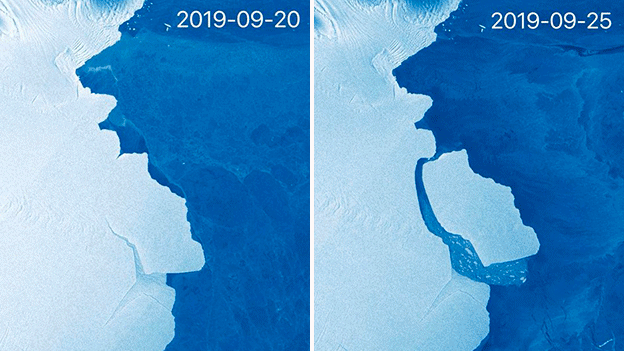In Antarctica, larger amounts of glacial ice break up and drift along in the ocean as icebergs – despite climate change – this is not an unusual event and usually not worth reporting. However, the natural phenomenon known as calving in glaciology has recently produced an iceberg the size of which has overshadowed the past.
We are talking about D-28 – the official name of the iceberg – that broke away from the so-called Amery Ice Shelf last week in eastern Antarctica. With a surface area of 1,636 square kilometers, the colossus is about the size of the entire urban area of London and only slightly smaller than the area of the canton of Freiburg (1671 square kilometers). This was announced by Copernicus, the EU Earth observation program.
Climate change not as a cause
Who fears that the demolition of the huge iceberg is due to climate change, may be reassured. Experts see the phenomenon as “part of a normal cycle” in the ice. Professor Helen Fricker of the American Scripps Institution of Oceanography told the BBC: “We do not think this event is related to climate change. This is part of the normal cycle in Ice Shelf, where we have major calf events every sixty to seventy years. “According to media reports, the demolition of the iceberg on the Amery Ice Shelf had been anticipated since the turn of the millennium. “While there is much to be concerned about in the Arctic, there is no reason for an alert in this particular case,” Fricker continued.
Exceptional is the size of D-28. Lastly, in the years 1963/64, a comparable amount of ice had replaced the Amery Ice Shelf. Due to its mass, the iceberg, which is now floating in the Southern Ocean, is monitored. Otherwise, it could be a threat to shipping. Nevertheless, D-28 is currently not the largest iceberg in the area. The “A68”, which broke off in July 2017 from the Larsen C ice shelf, should be about three times as large. The Alfred Wegener Institute for Polar and Marine Research gives its size with 5800 square kilometers, which corresponds approximately to the area of the canton of Bern (5959 square kilometers).
The Amery Ice Shelf in eastern Antarctica is about 400 kilometers long and 175 kilometers wide. With an area of 62,600 square kilometers, it is the third largest of its kind in the Antarctic after the Ross Ice Shelf and the Filchner-Ronne Ice Shelf. It has been under surveillance since the 1990s. Although its surface is said to have melted last summer, the ice shelf is still in balance with its environment, as the Scripps Institution of Oceanography puts it.
